 W
WFlightless birds are birds that through evolution lost the ability to fly. There are over 60 extant species, including the well known ratites and penguins. The smallest flightless bird is the Inaccessible Island rail. The largest flightless bird, which is also the largest living bird, is the ostrich. Ostriches are farmed for their decorative feathers, meat and their skins, which are used to make leather.
 W
WCassowaries , genus Casuarius, are ratites that are native to the tropical forests of New Guinea, East Nusa Tenggara, the Maluku Islands, and northeastern Australia.
 W
WThe southern cassowary, also known as double-wattled cassowary, Australian cassowary or two-wattled cassowary, is a large flightless black bird. It is one of the three living species of cassowary, alongside the dwarf cassowary and the northern cassowary. It is a ratite and therefore related to the emu, ostriches, rheas and kiwis.
 W
WThe bird family Casuariidae has four surviving members: the three species of cassowary and the emu.
 W
WThe Casuariiformes is an order of large flightless birds that has four surviving members: the three species of cassowary, and the only remaining species of emu. They are divided into either a single family, Casuariidae, or more typically two, with the emu splitting off into its own family, Dromaiidae.
 W
WThe flightless cormorant, also known as the Galapagos cormorant, is a cormorant endemic to the Galapagos Islands, and an example of the highly unusual fauna there. It is unique in that it is the only known cormorant that has lost the ability to fly. Once it was placed in its own genus, Nannopterum, although current taxonomy places it in the genus with most of the other cormorants, Phalacrocorax.
 W
WThe Henderson crake or red-eyed crake is a species of flightless bird in the family Rallidae. It is endemic to Henderson Island in the southeast Pacific Ocean. Its natural habitat is subtropical or tropical moist lowland forest.
 W
WDromaius is a genus of ratite present in Australia. There is one extant species, Dromaius novaehollandiae commonly known as the emu.
 W
WThe Chubut steamer duck or white-headed flightless steamer duck is a flightless duck endemic to Argentina.
 W
WThe Fuegian steamer duck or the Magellanic flightless steamer duck, is a flightless duck native to South America. It belongs to the steamer duck genus Tachyeres. It inhabits the rocky coasts and coastal islands from southern Chile and Chiloé to Tierra del Fuego, switching to the adjacent sheltered bays and lakes further inland when breeding.
 W
WThe emu is the second-largest living bird by height, after its ratite relative, the ostrich. It is endemic to Australia where it is the largest native bird and the only extant member of the genus Dromaius. The emu's range covers most of mainland Australia, but the Tasmanian, Kangaroo Island and King Island subspecies became extinct after the European settlement of Australia in 1788. The bird is sufficiently common for it to be rated as a least-concern species by the International Union for Conservation of Nature.
 W
WThe Falkland steamer duck is a steamer duck native to the Falkland Islands in the southern Atlantic Ocean. It is one of only two bird species endemic to the Falkland Islands, the other being Cobb's wren.
 W
WGargantuavis is an extinct genus of large, primitive bird containing the single species Gargantuavis philoinos. It is the only member of the monotypic family Gargantuaviidae. Its fossils were discovered in several formations dating to 73.5 and 71.5 million years ago in what is now northern Spain, southern France, and Romania. Gargantuavis is the largest known bird of the Mesozoic, a size ranging between the cassowary and the ostrich, and a mass of 140 kg (310 lb) like modern ostriches, exemplifying the extinction of non-avian dinosaurs was not a necessary condition for the emergence of giant terrestrial birds. It was once thought to be closely related to modern birds, but the 2019 discovery of a pelvis from what was Hateg Island shows several primitive features.
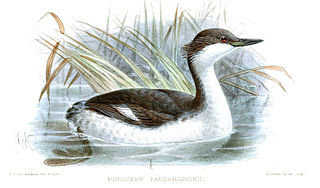 W
WThe Junín grebe, also known as Junin flightless grebe or puna grebe, is a grebe found only on Lake Junin in the highlands of Junín, west-central Peru. The grebe generally breeds in bays and channels around the edge of the Lake, within 8–75 m (26–246 ft) of reed beds, entering the reeds only for nesting or roosting. When not breeding, Junin grebe prefer open water, moving far out from lake shores. The current population is estimated at less than 250.
 W
WThe Guam rail is a species of flightless bird, endemic to the United States territory of Guam. The Guam rail disappeared from southern Guam in the early 1970s and was extirpated from the entire island by the late 1980s. This species is now being bred in captivity by the Division of Aquatic and Wildlife Resources on Guam and at some mainland U.S. zoos. Since 1995, more than 100 rails have been introduced on the island of Rota in the Commonwealth of the Northern Mariana Islands in an attempt to establish a wild breeding colony. Although at least one chick resulted from these efforts, feral cat predation and accidental deaths have been extremely high. In 2010, 16 birds were released onto Cocos Island, with 12 more being introduced in 2012. In 2019, the species became only the second bird after the California condor to be reclassified by the IUCN from extinct in the wild to critically endangered.
 W
WThe kagu or cagou is a crested, long-legged, and bluish-grey bird endemic to the dense mountain forests of New Caledonia. It is the only surviving member of the genus Rhynochetos and the family Rhynochetidae, although a second species has been described from the fossil record. Measuring 55 cm (22 in) in length, it has pale grey plumage and bright red legs. Its 'nasal corns' are a unique feature not shared with any other bird. Almost flightless, it spends its time on or near the ground, where it hunts its invertebrate prey, and builds a nest of sticks on the forest floor. Both parents share incubation of a single egg, as well as rearing the chick. It has proven vulnerable to introduced predators and is threatened with extinction.
 W
WThe kakapo, also called owl parrot, is a species of large, flightless, nocturnal, ground-dwelling parrot of the super-family Strigopoidea, endemic to New Zealand.
 W
WThe king penguin is the second largest species of penguin, smaller, but somewhat similar in appearance to the emperor penguin. There are two subspecies: A. p. patagonicus and A. p. halli; patagonicus is found in the South Atlantic and halli in the South Indian Ocean and at Macquarie Island.
 W
WKiwi or kiwis are flightless birds endemic to New Zealand, in the genus Apteryx and family Apterygidae. Approximately the size of a domestic chicken, kiwi are by far the smallest living ratites.
 W
WThe North Island brown kiwi, is a species of kiwi that is widespread in the northern two-thirds of the North Island of New Zealand and, with about 35,000 remaining, is the most common kiwi. This bird holds the world record for laying the largest eggs relative to its body size.
 W
WThe southern brown kiwi, tokoeka, or common kiwi is a species of kiwi from New Zealand's South Island. Until 2000 it was considered conspecific with the North Island brown kiwi, and still is by some authorities.
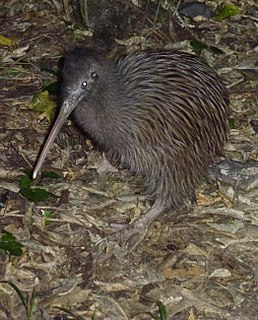 W
WThe Okarito kiwi also known as the rowi or Okarito brown kiwi, is a member of the kiwi family Apterygidae, described as new to science in 2003. The species is part of the brown kiwi complex, and is morphologically very similar to other members of that complex. It is found in a restricted area of the Okarito forest on the West Coast of New Zealand's South Island, and has a population of about only 600 birds. Some Okarito brown kiwi may live up to 100 years.
 W
WThe great spotted kiwi, great grey kiwi or roroa is a species of kiwi endemic to the South Island of New Zealand. The great spotted kiwi, as a member of the ratites, is flightless. It is the largest of the kiwi. The rugged topography and harsh climate of the high altitude alpine part of its habitat render it inhospitable to a number of introduced mammalian predators, which include dogs, ferrets, cats, and stoats. Because of this, populations of this species have been less seriously affected by the predations of these invasive species compared to other kiwi. Nonetheless, there has been a 43% decline in population in the past 45 years, due to these predators and habitat destruction. This has led it to be classified as vulnerable. There are less than 16,000 great spotted kiwis in total, almost all in the more mountainous parts of northwest Nelson, the northwest coast, and the Southern Alps. A minority live on island reserves.
 W
WThe Lord Howe woodhen also known as the Lord Howe Island woodhen or Lord Howe (Island) rail, is a flightless bird of the rail family, (Rallidae). It is endemic to Lord Howe Island off the Australian coast. It is currently classified as endangered by the IUCN.
 W
WThe Magellanic penguin is a South American penguin, breeding in coastal Patagonia, including Argentina, Chile and the Falkland Islands, with some migrating to Brazil where they are occasionally seen as far north as Espirito Santo. It is the most numerous of the Spheniscus penguins. Its nearest relatives are the African penguin, the Humboldt penguin, and the Galápagos penguins. The Magellanic penguin was named after Portuguese explorer Ferdinand Magellan, who spotted the birds in 1520. The species is listed as Near Threatened by the IUCN.
 W
WRecent studies show the northern rockhopper penguin, Moseley's rockhopper penguin, or Moseley's penguin distinct from the southern rockhopper penguin.
 W
WStruthio is a genus of birds in the order Struthioniformes, whose members are the ostriches. It is part of the infra-class Palaeognathae, a diverse group of flightless birds also known as ratites that includes the emus, rheas, and kiwis. There are two living species of ostrich, the common ostrich and the Somali ostrich.They are large flightless birds of Africa who lay the largest eggs of any living land animal. With the ability to run at 70 km/h, they are fastest bird on land. It is farmed worldwide, particularly for its feathers as they are used as decoration and feather dusters. Its skin is also used for leather products.
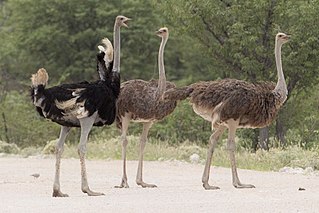 W
WThe common ostrich or simply ostrich, is a species of large flightless bird native to certain large areas of Africa. It is one of two extant species of ostriches, the only living members of the genus Struthio in the ratite order of birds. The other is the Somali ostrich, which was recognized as a distinct species by BirdLife International in 2014 having been previously considered a very distinctive subspecies of ostrich.
 W
WThe Somali ostrich, also known as the blue-necked ostrich, is a large flightless bird native to the Horn of Africa. It was previously considered a subspecies of the common ostrich, but was identified as a distinct species in 2014.
 W
WPenguins are a group of aquatic flightless birds. They live almost exclusively in the Southern Hemisphere, with only one species, the Galápagos penguin, found north of the equator. Highly adapted for life in the water, penguins have countershaded dark and white plumage and flippers for swimming. Most penguins feed on krill, fish, squid and other forms of sea life which they catch while swimming underwater. They spend roughly half of their lives on land and the other half in the sea.
 W
WThe African penguin, also known as the Cape penguin or South African penguin, is a species of penguin confined to southern African waters. Like all extant penguins, it is flightless, with a streamlined body and wings stiffened and flattened into flippers for a marine habitat. Adults weigh an average of 2.2–3.5 kg (4.9–7.7 lb) and are 60–70 cm (24–28 in) tall. The species has distinctive pink patches of skin above the eyes and a black facial mask. The body upperparts are black and sharply delineated from the white underparts, which are spotted and marked with a black band. The pink glands above their eyes help them with thermoregulation. To cope with changing temperatures, blood is sent to the glands to be cooled by the air.
 W
WThe gentoo penguin is a penguin species in the genus Pygoscelis, most closely related to the Adélie penguin and the chinstrap penguin. The earliest scientific description was made in 1781 by Johann Reinhold Forster with a type locality in the Falkland Islands. They call in a variety of ways, but the most frequently heard is a loud trumpeting which the bird emits with its head thrown back.
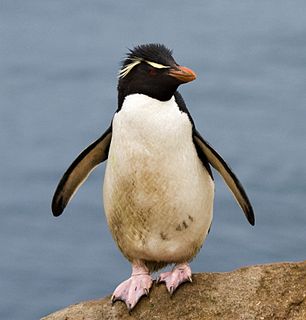 W
WThe southern rockhopper penguin group, are two subspecies of rockhopper penguin, that together are sometimes considered distinct from the northern rockhopper penguin. It occurs in subantarctic waters of the western Pacific and Indian Oceans, as well as around the southern coasts of South America.
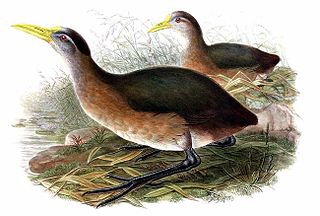 W
WThe New Guinea flightless rail, also known as the Papuan flightless rail, is a species of bird in the family Rallidae, in the monotypic genus Megacrex. Sometimes however, it was included in Amaurornis or Habroptila, but this is incorrect.
 W
WThe Inaccessible Island rail is a small bird of the rail family, Rallidae. Endemic to Inaccessible Island in the Tristan Archipelago in the isolated south Atlantic, it is the smallest extant flightless bird in the world. The species was described by physician Percy Lowe in 1923 but had first come to the attention of scientists 50 years earlier. The Inaccessible Island rail's affinities and origin were a long-standing mystery; in 2018 its closest relative was identified as the South American dot-winged crake, and it was proposed that both species should be nested within the genus Laterallus.
 W
WThe invisible rail, Wallace's rail, or drummer rail is a large flightless rail that is endemic to the island of Halmahera in Northern Maluku, Indonesia, where it inhabits impenetrable sago swamps adjacent to forests. Its plumage is predominantly dark slate-grey, and the bare skin around its eyes, the long, thick bill, and the legs are all bright red. Its call is a low drumming sound which is accompanied by wing-beating. The difficulty of seeing this shy bird in its dense habitat means that information on its behaviour is limited.
 W
WThe snoring rail, also known as the Celebes rail or Platen's rail, is a large flightless rail and the only member of the genus Aramidopsis. The species is endemic to Indonesia, and it is found exclusively in dense vegetation in wet areas of Sulawesi and nearby Buton. The rail has grey underparts, a white chin, brown wings and a rufous patch on the hind-neck. The sexes are similar, but the female has a brighter neck patch and a differently coloured bill and iris. The typical call is the snoring: ee-orrrr sound that gives the bird its English name.
 W
WA ratite is any of a diverse group of flightless and mostly large and long-legged birds of the infraclass Palaeognathae. Kiwi, however, are relatively much smaller and shorter-legged, as well as being the only nocturnal extant ratites.
 W
WThe rheas are large ratites in the order Rheiformes, native to South America, distantly related to the ostrich and emu. Most taxonomic authorities recognize two extant species: the greater or American rhea and the lesser or Darwin's rhea. The IUCN lists the puna rhea as a separate species. The IUCN currently rates the greater and puna rheas as near-threatened in their native ranges, while Darwin's rhea is of least concern. In addition, a feral population of the greater rhea in Germany appears to be growing, though control efforts are underway, and seem to be succeeding in controlling the birds' population growth.
 W
WDarwin's rhea, also known as the lesser rhea, is a large flightless bird, but the smaller of the two extant species of rheas. It is found in the Altiplano and Patagonia in South America.
 W
WThe rockhopper penguins are three closely related taxa of crested penguins that have been traditionally treated as a single species and are sometimes split into three species.
 W
WThe takahē, also known as the South Island takahē or notornis, is a flightless bird indigenous to New Zealand, and the largest living member of the rail family. First encountered by Europeans in 1847, just four specimens were collected in the 19th century. After the final bird was captured in 1898, and no more were to be found, the species was presumed extinct. Fifty years later, however, after a carefully planned search, takahē were dramatically rediscovered in 1948 by Geoffrey Orbell in an isolated valley in the South Island's Murchison Mountains. The species is now managed by the New Zealand Department of Conservation, whose Takahē Recovery Programme maintains populations on several offshore islands as well as Takahē Valley. It has now been reintroduced to a second mainland site in Kahurangi National Park. Although takahē are still a threatened species, their NZTCS status was downgraded in 2016 from Nationally Critical to Nationally Vulnerable. The population is 418 and is growing by 10 percent a year.
 W
WThe Tasmanian native hen is a flightless rail and one of twelve species of birds endemic to the Australian island of Tasmania. Although many flightless birds have a history of extinction at the hands of humans, the Tasmanian native hen has actually benefited from the introduction of European-style agricultural practices in Tasmania.
 W
WThe Titicaca grebe, also known as the Titicaca flightless grebe or short-winged grebe, is a grebe found on the altiplano of Peru and Bolivia. As its name implies, its main population occurs on Lake Titicaca. Lake Uru Uru and Poopó, the Rio Desaguadero, and small lakes that connect to Lake Titicaca in wet years, serve as "spillovers" territory. In the past, the population was larger and several of these lakes – such as Lakes Umayo and Arapa – apparently had and may still have permanent large colonies. It is sometimes placed in Podiceps or a monotypic genus Centropelma. Its local name is zampullín del Titicaca.
 W
WThe weka is a flightless bird species of the rail family. It is endemic to New Zealand. Four subspecies are recognized but only two (northern/southern) are supported by genetic evidence. Weka are sturdy brown birds, about the size of a chicken. As omnivores, they feed mainly on invertebrates and fruit. Weka usually lay eggs between August and January; both sexes help to incubate.